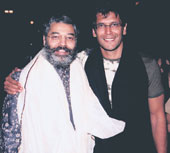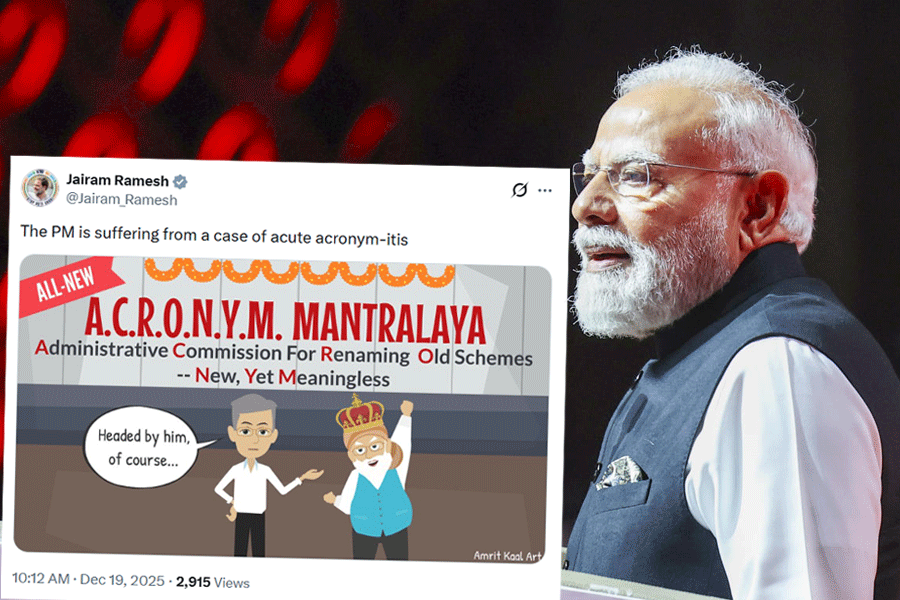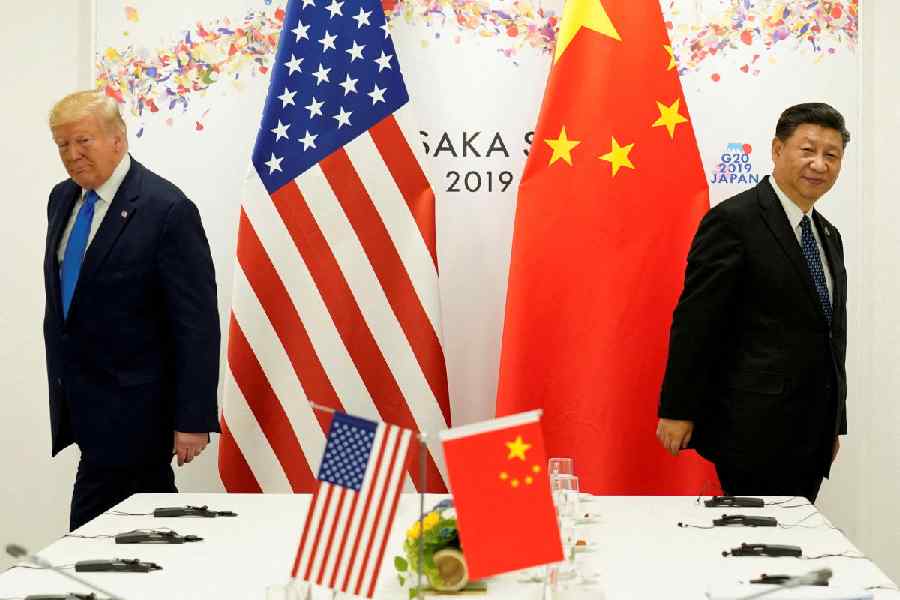 |
 |
 |
 |
 |
| (From top to bottom): Tikka Shatrujit Singh (left) wearing a bamboo textile achkan with kantha embroidery and Milind Soman in a bamboo stole ; (right) Baichung Bhutia sporting a bamboo chanderi saropa with Kelly Dorji (left) in a bamboo appliqué kurta from Rajasthan; bamboo furniture on display; bamboo shoots — now a health food; a bamboo structure designed by Simon Velez |
The trousers were suave, skirts ephemeral and drawstring pants relaxed ? naturally textured, beautifully toned. Lightweight, comfortable, versatile, the crisp fabric pirouetted on the ramp as kurtas, tunics, achkans, blouses and more. It looked like linen but wasn?t. Rather, it was the ?new find? ? bamboo fabric ? which is out to make a bold fashion statement. In fact, when the model wearing bamboo strutted down the ramp at the last International Bamboo Congress, it left the audience, even the designer, gazing awestruck that bamboo could look so good.
Now cut to ace Indian architect Pradeep Sachdev. He?s poised to give the capital two bamboo structures. And as you would expect from Sachdev, the constructions are not going to be cheap. He?s building a bridge and a pavilion that will find pride of place in Delhi?s new leisure spot, the Garden of Five Senses. In league with Colombian architect, Simon Velez, whose forte is extravagant bamboo structures, Sachdev is excited about helping bamboo cast off its low-cost image. And just in case you are interested, the project will be completed at a whopping Rs 80 lakh (and Sachdev is still counting).
We all know about bamboo. But now efforts are on to give this giant grass (yes, it?s a grass) a makeover that will catapult it into the realms of a top-end resource. ?People all over the world are discovering innovative ways to use bamboo,? says V. S. Oberoi, Mission Director of the three-year-old National Mission on Bamboo Applications (NMBA).
Yes, bamboo, a staple of Asia, is hotter than ever. You can wear it, eat it, build with it ? and also make it a tool for economic growth. So did you ever think that the poor man?s timber could reposition itself as the stuff of high fashion? Or that it could go beyond giving the world fences, fishing rods, flutes, boatmen?s oars and the poles that vaulters fly by? Bamboo has been around for what seems like forever, best identified as scaffolding, temporary platforms and support structures holding up buildings as they are being built. It?s also been the preferred material for handicrafts woven into utilitarian baskets, floor mats, toys, odds--ends with prices anywhere from Rs 15 to Rs 350.
Today bamboo is reinventing itself as a preferred material in a variety of applications. It?s replacing teak and is being knocked onto floors and paired with fibre-glass, on rooftops. And it?s making its way into plush living-rooms and dens, lending an earthy air to interiors. It?s also the hot material being used liberally in public areas in holiday resorts the world over.
So what is bamboo? Well, we know it?s a grass. But let?s get this clear ? it is no ordinary grass. According Sachdev, it?s a sustainable resource of incalculable value. It?s environment friendly and while other woods take decades to mature, bamboo is the fastest-growing woody plant, it can grow pretty well anywhere but flourishes in the North-East and it can be harvested within three to four years of planting.
If once looked upon as old-fashioned and colonial, its new look is fresh and happening. Move over steel and plastic as the world of bamboo taxis for a takeoff. Indians have been taking note of bamboo as a powerful alternative material thanks to design and engineering research and savvy. ?It?s a renewable, light yet strong, versatile and readily available economic resource. And above all, its environment friendly,? says Professor MP Ranjan, Faculty of Design Head, NID Centre for Bamboo Initiatives and author of Bamboo & Cane Crafts of Northeast India. The icing to the cake is the little-known fact that its structural properties can be compared to those of steel. Bamboo is the new building alternative and it comes with punch.
So it?s now possible to convert your living room or bedroom into a stylish tropical paradise with bamboo furniture and accessories. Of course we?re talking about swishly designed furniture, not dowdy garden furniture. ?There?s nothing as exotic or peaceful as bamboo furniture,? says interior designer Punam Kalra. ?There?s a striking beauty of colour and form that comes with doses of tranquility.?
 |
 |
| Designer Madhu Jain in a bamboo kurta and (above) Tinu Joseph in a chanderi bamboo skirt with a backless tunic |
A touch of bamboo is often the perfect accessory for a setting by way of a screen, a shelf or even a lounger. ?The graceful lines and lightweight, portable characteristic of bamboo furniture infuses interiors with an informal, airy look,? says Kalra. At the same time, it?s durable and strong, doesn?t shrink or swell like some other hardwoods, making it comparable to teak as a hardy indoor and outdoor furniture material. And caring for bamboo furniture is akin to looking after any other wood. It can be dusted, polished, painted or axed.
Others are sending out the same message. The VII World Bamboo Congress, for instance, gave bamboo a completely new twist by presenting clothes made out of bamboo. Designer Madhu Jain along with model-turned-actor Milind Soman cut the lesser known bamboo fabric into contemporary silhouettes. Jain looks back, ?The fabric is magical and lends itself completely to high fashion.?
Jain explains that like linen, bamboo fabric may crush but it doesn?t shrink. It?s comparable in look and feel to sophisticated linen and has many other similar properties. It breathes like any other natural fabric, is cool and subtly lustrous. Soft as cashmere, it has great absorption performance and thus also has anti-bacterial properties. Jain explains, ?As the bamboo fibre is filled with micro-gaps and micro-holes, it offers greater absorption and ventilation than other fabrics.? Just for the record, bamboo absorbs four times as much perspiration as cotton. In a nutshell, it?s perfect for blazing Indian summers.
Taking advantage of bamboo?s anti-bacterial properties, NMBA feels another key production area should be manufacturing sanitary materials such as gauze masks, absorbent pads and food packaging materials.
What?s more, bamboo is also being pushed as a health food as it contains fibre and is high in potassium. In some parts of the world, bamboo shoot is a delicacy to be savoured ? we?ve all seen pictures of those pandas nibbling away but it?s good for humans too. This makes it a good addition to simmered foods as it soaks up flavour while retaining its own flavour and crisp texture. Today it is also hitting kitchens as pickles.
It doesn?t end there. The decline in availability of timber and the emergence of new technologies has spurred interest in the field of wood substitutes. Today a range has emerged of products and applications that use bamboo in newer, value-added ways. These have emerged through scientific and engineering skills. As structural material, bamboo carries huge advantages in its strength and lightness. For one, well-constructed bamboo buildings are inherently resistant to wind and earthquakes. Besides, a bamboo construction needn?t ?look? low-cost as imaginative design can overcome that problem. Also with bamboo substituting for timber, fewer forests would have to be cut down, reducing deforestation. ?It spreads and is not harmed by harvesting,? explains Oberoi. You can hack it down completely and then watch it grow right back.
And if the mention of bamboo flooring conjures up images of something low-brow, you can think again. Bamboo flooring is far from flimsy. It?s harder than even the mighty oak. ?The expansion and contraction of bamboo flooring is much less than hardwoods,? promises Sachdev.
Bamboo flooring is typically factory pre-finished and is installed like any other hardwood floor ? by nailing it or gluing it down. This flooring can be sanded and refinished like any other. It scratches also like any other wood floor, but can be just as easily refinished. If a regular stone floor costs between Rs 40 to Rs 110 per square foot, a bamboo cover can set you back by Rs 150 per square foot.
?Above all, bamboo could well be a development strategy for rural India,? says Ranjan. If some 2.5 billion people worldwide are in some ways connected to this plant, it?s the potential tool of rural, economic and industrial development. Many developing countries are rich in bamboo, but poor management results in wasting this resource.
The Chinese experience shows that developing bamboo is an important way of boosting rural income. And Ranjan, who is passionate about bamboo, has spent decades researching a particular species of bamboo ? the Bambusa affinis ? that grows in Western Tripura. Katlamara may be in the back of beyond (40km off Tripura?s capital Agartala), but here a specific species of bamboo is giving the local rural community much to do.
?A little push can transform bamboo into a money-spinner,? promises Oberoi. So perhaps it won?t be long before the grass becomes all the rage.
Photographs of Bamboo Mission by Rupinder Sharma
Bamboo reinvents itself as...
 |
 |
• A linen-like fabric that is soft, cool and lustrous
• lA new-age construction material that after processing can replace timber. Bamboo board can be used for as many purposes as timber boards; bamboo mat boards are the equivalent of superior plywood and bamboo ply board is strong and can also be made water-resistant. Bamboo corrugated mat roofing sheets are an option for the roof
• Pre-fabricated army shelters that are portable and easy to assemble, eco-friendly and have a life span of some 10 years.
• Shelter belts with the bamboo clumps that act as wind breaks for coastal and desert areas
• Perimeter fencing and camouflage for the army in sensitive areas
• Bamboo charcoal gives clean combustion and does not have pungent fumes.
• Gasification of bamboo produces energy that can generate electricity
• Bamboo shoots are a food delicacy to be savoured
• Traditional products including incense sticks, baskets, mats, furniture, trays, handicrafts and more
Why bamboo?
 |
• It’s a hardy grass, a strong and versatile material that grows easily and quickly. It’s renewable and unlike timber can be harvested every year.
• Environment friendly: Cutting down bamboo has minimal effect on the environment since bamboo can be harvested three years after being planted.
• Is easily available, easy to use and work with.
• It has new uses in high-value products and applications.
• Bamboo contributes to the soil and environment and its root and rhizome structures act as binders, control erosion and rejuvenate the soil.











